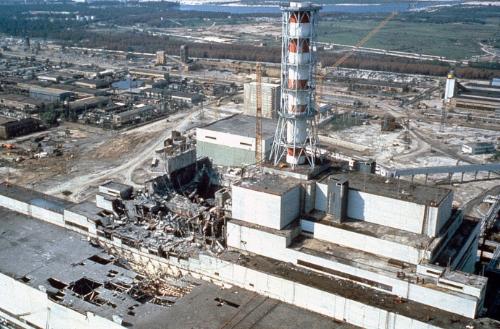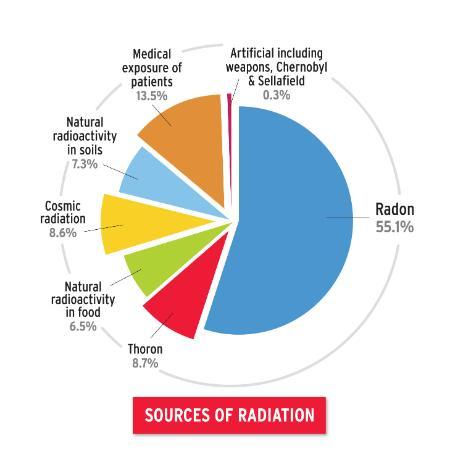On April 26, 1986 the most serious accident in the history of nuclear power operation took place at the Chernobyl nuclear power station in the Ukraine.
What were the health effects of the accident?
How did the radioactive plume affect Ireland?
Are we still exposed to radiation from Chernobyl today?
Further reading and information
In violation of safety regulations, the operators of the Unit 4 at the Chernobyl nuclear power plant were experimentally testing the electrical control system as the reactor was being shut down for routine maintenance. They switched off important control systems and allowed the reactor to reach unstable low-power conditions.
Inherent design flaws in the reactor led to a sudden power surge, which caused a steam explosion that ruptured the reactor vessel. Further violent fuel-steam interactions destroyed the reactor core and severely damaged the reactor building. Exposed to the air, the reactor core burned in an intense graphite fire for 10 days. Massive amounts of radioactivity were released into the environment.
After the accident, access to the area in a 30 km radius around the plant was closed, except for people requiring official access to the plant and to the immediate area for evaluating and dealing with the aftermath of the accident and for operation of the other reactor units at the site. Approximately 115,000 people were evacuated from the most heavily contaminated areas surrounding the reactor in 1986 and a further 220,000 people from Belarus, the Russian Federation and Ukraine were relocated in the following years.
The initial explosion and subsequent fire ejected radioactivity high into the atmosphere which was subsequently spread by the wind. The plume of radioactivity spread over the countries of Ukraine, Belarus and the Russian Federation and to a lesser extent, the countries in the rest of Europe.

Among the approximately 600 workers present on the site at the time of the accident, 134 received very high radiation doses and suffered from acute radiation sickness. Of these, twenty eight workers died in the first three months after the accident and another 19 died between 1987 – 2004 of various causes not necessarily associated with radiation exposure.
Another 200,000 recovery workers involved in the initial cleanup work of 1986-1987 received doses of between 10 and 500 millisievert (mSv). By 1990, the number of workers involved in cleanup activities at Chernobyl rose to about 600,000. These workers are still at potential risk of late consequences such as cancer and other diseases and their health is being closely monitored on an ongoing basis.
Average doses to Ukrainian and Belarusian evacuees were 17 millisievert (mSv) and 31 mSv, respectively - individual exposures ranged from a low of 0.1 to 380 mSv. In addition to causing radiation exposure, the accident caused long-term changes to the lives of the people living in contaminated districts, since the measures intended to limit radiation doses included resettlement, changes in food supplies and restriction on the activities of individuals and families.
The health of these residents also has been monitored since 1986, and has focused on investigating the association between exposure caused by radionuclides released in the Chernobyl accident and late effects, in particular, thyroid cancer in children. A large number of children and adolescents in Belarus, Ukraine and the Russian regions most affected received substantial radiation doses to the thyroid from drinking milk contaminated with radioactive iodine in the first few months after the accident.
By 2006, more than 5000 cases of thyroid cancer were diagnosed among those who were children at the time of the exposure. By 2015, the total number of cases in the three affected countries had reached 20,000.
Based on data published up to 2018, the United Nations Scientific Committee on the Effects of Atomic Radiation (UNSCEAR) has concluded that, apart from the dramatic increase in thyroid cancer incidence among those exposed at a young age, and some indication of an increased leukemia and cataract incidence among the workers, there is no clearly demonstrated increase in the incidence of solid cancers or leukemia due to radiation in the exposed populations. Neither is there any proof of other non-malignant disorders that are related to ionising radiation. UNSCEAR observes that many other health problems have been noted in the populations that are not related to radiation exposure.
Authoritative, scientific reports on the health and environmental aspects of the Chernobyl accident are listed below.
Part of the radioactive plume spread south westwards across Europe, and from Poland a section moved northward towards Ireland. A sharp rise in radioactivity was recorded on air filters at Glasnevin on May 2, 1986, indicating the arrival of the radioactive plume over Ireland.
Patchy rainfall washed some radioactivity from the plume as it passed over Ireland leading to patchy deposition of radioactivity across Ireland.
In common with other European countries, a major monitoring programme was initiated in Ireland.
The extent of contamination was assessed, and the Irish population’s radiation dose was estimated. The programme involved testing foodstuffs, air filters, drinking water, vegetation, rain water and other environmental materials.
At the time, foodstuffs proved to be the biggest potential source of exposure to radiation from Chernobyl. The national monitoring programme, therefore, concentrated on the testing of milk, vegetables, meat and other foodstuffs.
Ireland adopted the same safety level for radiation as other European countries at the time. During the six months following the accident this safety level was only exceeded in one sample. It was considered unnecessary to restrict the sale or consumption of foodstuffs produced within Ireland.
The radiation exposure to the Irish population, as a result of the Chernobyl accident, has been estimated based on the large number of foodstuffs and environmental samples measured at the time.
It was calculated that Chernobyl resulted in an approximate 3 per cent increase in radiation exposure to the average Irish person in the 12 months following the accident.
Given that the radioactivity levels in the environment decreased rapidly in the months and years following the accident, the additional exposure to the Irish population in subsequent years would have been very much less.
Today the radiation dose to the Irish population from Chernobyl is indistinguishable from the usual background radiation. Find out more about the types of radiation we are exposed to.

Chernobyl, In Focus (International Atomic Energy Agency)
United Nations Scientific Committee on the Effects of Atomic Radiation (UNSCEAR)